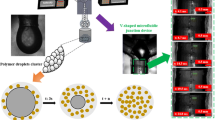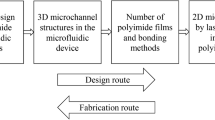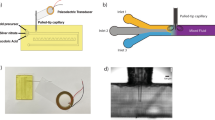Abstract
Surface gold–polymer nanocomposites are prepared by using the thermal convection method for the deposition of gold colloids onto the surface of four polymer films: poly(-vinyl alcohol) (PVA), SU-82, poly(styrene) (PS), and poly(dimethyl siloxane) (PDMS). In order to increase the plasmonic sensitivity of the platforms, the nanocomposites are, subsequently, subjected to an incremental heating in the range of 80–200 °C. As a consequence, small aggregates are formed and uniformly dispersed on the surface of the film. In addition, because of the softening of the polymer, a small fraction of nanoparticles “sinks” into the surface layer. Because of the different thermal properties of the polymers and the interac-tions between the nanoparticles and the polymer chains, the final configuration of the thermally “manipulated” nanocom-posites will not be the same. It is found that, among the poly-mers studied in this work, PVA and SU-82 show the largest shift of the Au localized surface plasmon resonance (LSPR) band upon the incremental heating as well as the highest plasmonic sensitivity. It is thought that the thermal manipulation may be a useful method for increasing the plasmonic sensitiv-ity of a platform. The results of this work will be helpful in selecting the best material for microfluidic sensing experiments.












Similar content being viewed by others

References
Barber DJ, Freestrone IC (1990) An investigation of the origin of the colour of the lycurgus cup by analytical transmission electron microscopy. Archaeometry 32:33–45
Neri A (1612) L’arte vetraria. Giunti, Firenze
Caseri WR (2014) In situ synthesis of polymer-embedded nanostructures. Nanocomposites: In situ Synthesis of Polymer-Embedded Nanostructures 1:45–47
Nicolais L, Carotenuto G (2014) Preparation and characterization of metal-polymer nanocomposites. Nanocomposites: In situ Synthesis of Polymer-Embedded Nanostructures 1:73–96
Katz E, Willner I (2004) Integrated nanoparticle-biomolecule hybrid systems: synthesis, properties, and applications. Angew Chem 43:6042–6108
Jain PK, Lee KS, El-Sayed IH, El-Sayed MA (2006) Calculated absorption and scattering properties of gold nanoparticles of different size, shape, and composition: applications in biological imaging and biomedicine. J Phys Chem 110:7238–7248
Huang X, El-Sayed IH, Qian W, El-Sayed MA (2006) Cancer cell imaging and photothermal therapy in the near-infrared region by using gold nanorods. J Am Chem Soc 128:2115–2120
Durr NJ, Larson T, Smith DK, Korger BA, Sokolov K, Ben-Yakar A (2007) Two-photon luminescence imaging of cancer cells using molecularly targeted gold nanorods. Nano letter 7:941–945
Nasir SM, Nur H (2008) Gold nanoparticles embedded on the surface of polyvinyl alcohol layer. Journal of Fundamental Sciences 4:245–252
Liu FK, Hsieh SY, Ko FH, Chu TC (2003) Synthesis of golf/poly(methyl methacrylate) hybrid nanocomposites. Colloids and Surfaces 231:31–38
Loo C, Lowery A, Halas N, West J, Drezek R (2005) Immunotargeted nanoshells for integrated cancer imaging and therapy. Nano Lett 5:709–711
Uehara N (2010) Polymer-functionalized gold nanoparticles as versatile sensing materials. Anal Sci 26:1219–1228
Ramesh GV, Porel S, Radhakrishnan TP (2009) Polymer thin films embedded with in situ grown metal nanoparticles. Chem Soc Rev 38:2646–2656
Alsawafta M, Badilescu S, Paneri A, Truong VV,M, Packirisamy M (2011) Gold-poly(methyl methacrylate) nanocomposite films for plasmonic biosensing applications. Polymers 3:1833–1848
Porel S, Singh S, Harsha SS, Rao DN, Radhakrishnan TP (2005) Nanoparticle embedded polymer: in situ synthesis, free-standing films with highly monodisperse silver nanoparticles and optical limiting. Chem Mater 17:9–12
Putla RK (2010) Monitoring of glass transition at a polymer surface by localized surface plasmon resonance. Thesis Oklahoma State University
Pini V, Kosaka PM, Ruz JJ, Malvar O, Encinar M, Tamayo J, Calleja M (2016) Spatially multiplexed dark-field microspectrophotometry for nanoplasmonics. Nature Scientific Reports
Karakouz T, Maoz BM, Lando G, Vaskevich A, Rubinstein I (2011) Stabilization of gold nanoparticle films on glass by thermal embedding. Applied Material & Interfaces 3:978–987
Author information
Authors and Affiliations
Corresponding author
Rights and permissions
About this article
Cite this article
Fanous, M., Badilescu, S. & Packirisamy, M. Thermal Manipulation of Gold Nanocomposites for Microfluidic Platform Optimization. Plasmonics 13, 305–313 (2018). https://doi.org/10.1007/s11468-017-0515-3
Received:
Accepted:
Published:
Issue Date:
DOI: https://doi.org/10.1007/s11468-017-0515-3



